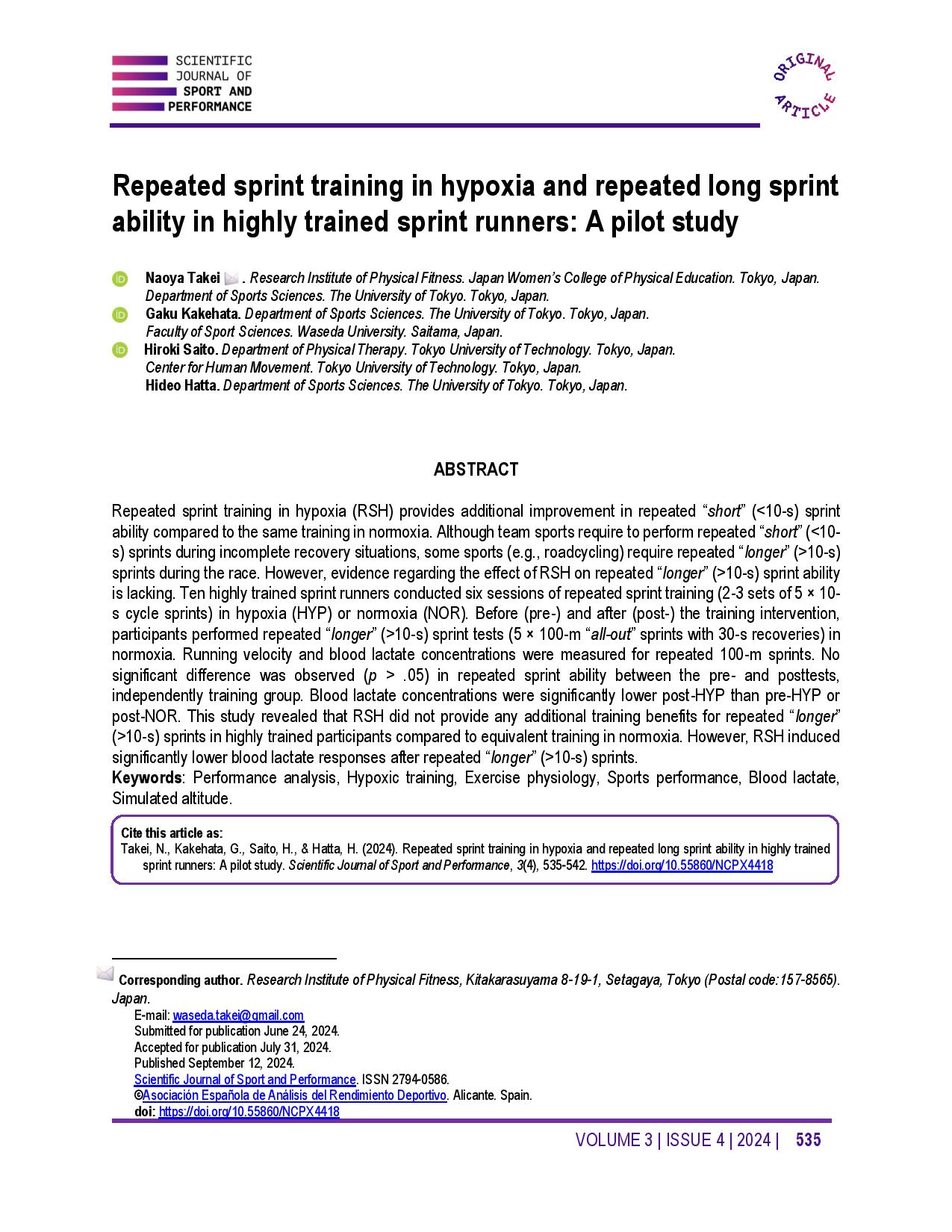Repeated sprint training in hypoxia and repeated long sprint ability in highly trained sprint runners A pilot study
Main Article Content
Abstract
Repeated sprint training in hypoxia (RSH) provides additional improvement in repeated “short” (<10-s) sprint ability compared to the same training in normoxia. Although team sports require to perform repeated “short” (<10-s) sprints during incomplete recovery situations, some sports (e.g., roadcycling) require repeated “longer” (>10-s) sprints during the race. However, evidence regarding the effect of RSH on repeated “longer” (>10-s) sprint ability is lacking. Ten highly trained sprint runners conducted six sessions of repeated sprint training (2-3 sets of 5 × 10-s cycle sprints) in hypoxia (HYP) or normoxia (NOR). Before (pre-) and after (post-) the training intervention, participants performed repeated “longer” (>10-s) sprint tests (5 × 100-m “all-out” sprints with 30-s recoveries) in normoxia. Running velocity and blood lactate concentrations were measured for repeated 100-m sprints. No significant difference was observed (p > .05) in repeated sprint ability between the pre- and posttests, independently training group. Blood lactate concentrations were significantly lower post-HYP than pre-HYP or post-NOR. This study revealed that RSH did not provide any additional training benefits for repeated “longer” (>10-s) sprints in highly trained participants compared to equivalent training in normoxia. However, RSH induced significantly lower blood lactate responses after repeated “longer” (>10-s) sprints.
Article Details

This work is licensed under a Creative Commons Attribution-NonCommercial-ShareAlike 4.0 International License.
Funding data
-
Japan Society for the Promotion of Science
Grant numbers 22K17693
References
Bishop, D., Girard, O., & Mendez-Villanueva, A. (2011). Repeated-sprint ability - part II: recommendations for training. Sports Medicine, 41(9), 741-756. https://doi.org/10.2165/11590560-000000000-00000 DOI: https://doi.org/10.2165/11590560-000000000-00000
Brocherie, F., Girard, O., Faiss, R., & Millet, G. P. (2017). Effects of Repeated-Sprint Training in Hypoxia on Sea-Level Performance: A Meta-Analysis. Sports Medicine, 47(8), 1651-1660. https://doi.org/10.1007/s40279-017-0685-3 DOI: https://doi.org/10.1007/s40279-017-0685-3
Brooks, G. A. (2018). The Science and Translation of Lactate Shuttle Theory. Cell Metabolism, 27(4), 757-785. https://doi.org/10.1016/j.cmet.2018.03.008 DOI: https://doi.org/10.1016/j.cmet.2018.03.008
Ebert, T. R., Martin, D. T., Stephens, B., & Withers, R. T. (2006). Power output during a professional men's road-cycling tour. International Journal of Sports Physiology and Performance, 1(4), 324-335. https://doi.org/10.1123/ijspp.1.4.324 DOI: https://doi.org/10.1123/ijspp.1.4.324
Faiss, R., Girard, O., & Millet, G. P. (2013A). Advancing hypoxic training in team sports: from intermittent hypoxic training to repeated sprint training in hypoxia. British Journal of Sports Medicine, 47 Suppl 1(Suppl 1), i45-i50. https://doi.org/10.1136/bjsports-2013-092741 DOI: https://doi.org/10.1136/bjsports-2013-092741
Faiss, R., Léger, B., Vesin, J.-M., Fournier, P.-E., Eggel, Y., Dériaz, O., & Millet, G. P. (2013B). Significant molecular and systemic adaptations after repeated sprint training in hypoxia. PloS One, 8(2), e56522. https://doi.org/10.1371/journal.pone.0056522 DOI: https://doi.org/10.1371/journal.pone.0056522
Gastin, P. B. (2001). Energy system interaction and relative contribution during maximal exercise. Sports Medicine, 31(10), 725-741. https://doi.org/10.2165/00007256-200131100-00003 DOI: https://doi.org/10.2165/00007256-200131100-00003
Gatterer, H., Menz, V., Salazar-Martinez, E., Sumbalova, Z., Garcia-Souza, L. F., Velika, B., Gnaiger, E., & Burtscher, M. (2018). Exercise Performance, Muscle Oxygen Extraction and Blood Cell Mitochondrial Respiration after Repeated-Sprint and Sprint Interval Training in Hypoxia: A Pilot Study. Journal of Sports Science & Medicine, 17(3), 339-347.
Girard, O., Mendez-Villanueva, A., & Bishop, D. (2011). Repeated-sprint ability - part I: factors contributing to fatigue. Sports Medicine, 41(8), 673-694. https://doi.org/10.2165/11590550-000000000-00000 DOI: https://doi.org/10.2165/11590550-000000000-00000
Greenhaff, P. L., & Timmons, J. A. (1998). Interaction between aerobic and anaerobic metabolism during intense muscle contraction. Exercise and Sport Sciences Reviews, 26, 1-30. https://doi.org/10.1249/00003677-199800260-00003 DOI: https://doi.org/10.1249/00003677-199800260-00003
Kakehata, G., Goto, Y., Iso, S., & Kanosue, K. (2022). The Timing of Thigh Muscle Activity Is a Factor Limiting Performance in the Deceleration Phase of the 100-m Dash. Medicine and Science in Sports and Exercise, 54(6), 1002-1012. https://doi.org/10.1249/MSS.0000000000002876 DOI: https://doi.org/10.1249/MSS.0000000000002876
Kasai, N., Mizuno, S., Ishimoto, S., Sakamoto, E., Maruta, M., Kurihara, T., Kurosawa, Y., & Goto, K. (2019). Impact of Six Consecutive Days of Sprint Training in Hypoxia on Performance in Competitive Sprint Runners. Journal of Strength and Conditioning Research, 33(1), 36-43. https://doi.org/10.1519/JSC.0000000000001954 DOI: https://doi.org/10.1519/JSC.0000000000001954
McKay, A. K. A., Stellingwerff, T., Smith, E. S., Martin, D. T., Mujika, I., Goosey-Tolfrey, V. L., Sheppard, J., & Burke, L. M. (2022). Defining Training and Performance Caliber: A Participant Classification Framework. International Journal of Sports Physiology and Performance, 17(2), 317-331. https://doi.org/10.1123/ijspp.2021-0451 DOI: https://doi.org/10.1123/ijspp.2021-0451
Parolin, M. L., Chesley, A., Matsos, M. P., Spriet, L. L., Jones, N. L., & Heigenhauser, G. J. (1999). Regulation of skeletal muscle glycogen phosphorylase and PDH during maximal intermittent exercise. The American Journal of Physiology, 277(5), E890-E900. https://doi.org/10.1152/ajpendo.1999.277.5.E890 DOI: https://doi.org/10.1152/ajpendo.1999.277.5.E890
Puype, J., Van Proeyen, K., Raymackers, J.-M., Deldicque, L., & Hespel, P. (2013). Sprint interval training in hypoxia stimulates glycolytic enzyme activity. Medicine and Science in Sports and Exercise, 45(11), 2166-2174. https://doi.org/10.1249/MSS.0b013e31829734ae DOI: https://doi.org/10.1249/MSS.0b013e31829734ae
Suzuki, J. (2019). Effects of exercise training with short-duration intermittent hypoxia on endurance performance and muscle metabolism in well-trained mice. Physiological Reports, 7(14), e14182. https://doi.org/10.14814/phy2.14182 DOI: https://doi.org/10.14814/phy2.14182
Tai, M. M. (1994). A mathematical model for the determination of total area under glucose tolerance and other metabolic curves. Diabetes Care, 17(2), 152-154. https://doi.org/10.2337/diacare.17.2.152 DOI: https://doi.org/10.2337/diacare.17.2.152
Takei, N., Kakinoki, K., Girard, O., & Hatta, H. (2020). Short-Term Repeated Wingate Training in Hypoxia and Normoxia in Sprinters. Frontiers in Sports and Active Living, 2, 43. https://doi.org/10.3389/fspor.2020.00043 DOI: https://doi.org/10.3389/fspor.2020.00043




